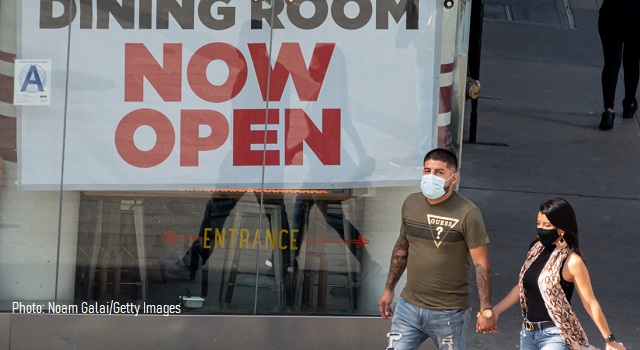10 Counties With Most COVID-19 Deaths Account for 22% of Fatalities but 11% of Population

As Heritage Foundation researchers have demonstrated throughout the pandemic, the spread of COVID-19 in the U.S. has been heavily concentrated in a small number of states—and among a small number of counties within those states.
Heritage’s interactive graphic allows individuals to see more detail on these concentrations of COVID-19 among the counties with the most deaths as well as those with the fewest.
For instance, the graphic allows users to select data from the five counties with the most coronavirus-related deaths all the way up to the 50 counties with the most such deaths. It also allows visitors to select data from counties with zero deaths to counties with 10 deaths or fewer.
As of Oct. 12, the 10 counties with the most COVID-19 deaths account for 22.3% of all related deaths in the U.S. but only 11.2% of the population. The 30 counties with the most coronavirus deaths account for 37.4% of the related deaths in the U.S. and only 19.6% of the U.S. population.
How are socialists deluding a whole generation? Learn more now >>
Three of the five counties of New York City, one of the hardest-hit areas in the early stages of the pandemic, still account for three of the five U.S. counties with the most coronavirus deaths. New York City still has a disproportionate effect on the perceived COVID-19 experience in the U.S.
According to the Centers for Disease Control and Prevention, New York City has a coronavirus death rate of 284 per 100,000; the rest of the state has a rate of 81 per 100,000. The average COVID-19 death rate for the entirety of the U.S. is roughly 65 per 100,000. (For more on how New York City skews COVID-19 data in the U.S., see this Heritage Backgrounder.)
This evidence suggests that as new locations in the U.S. experienced surges in COVID-19 cases throughout this pandemic, death rates remained lower.
Ultimately, several items could be at play, including a different, younger population being infected in many locations, such as Florida, during a surge in the disease. Additionally, better treatment and lessons learned from coping with the pandemic could be part of the lower death rates, including lessons learned in limiting exposure in vulnerable populations, such as the elderly.
Although still tragic, the outlook has improved over the past month.
As of Sept. 4, the Institute for Health Metrics and Evaluation’s model projected that the U.S. would have 400,000 deaths from COVID-19 by Jan. 1, 2021. But as of now, the model has lowered its worst-case scenario to 338,735 deaths by Jan. 1, with its current projection 7% lower at 316,935 deaths.
Even so, to reach that new number by Jan. 1, the average daily death rate from COVID-19 would have to be roughly 1,300. The seven- and 14-day average death rates for the U.S. have not been that high since May 20.
The worst day prior to May 20 saw an average of roughly 2,200 deaths, a figure that falls to 1,659 if New York City is excluded. The worst day since May 20 was a seven-day average of 1,215 on Aug. 1.
Now that COVID-19 testing has increased dramatically and many state and local governments have relaxed stay-at-home orders, it is even more critical to study the trends in deaths along with cases.
To make studying these trends easier, The Heritage Foundation now has two interactive COVID-19 trackers. One tracks trends in cases, the other tracks trends in deaths.
The trackers describe whether the trend of cases—or deaths—is increasing or decreasing over the prior 14 days. They also provide a visual depiction of new cases—or deaths—during this time period.
These tools help put the concentrated nature of the pandemic in perspective with county-level data. They show just how difficult it can be to use only one metric to gauge whether a county—or state—is doing well.
Readers are invited to explore the information in the tracker and check back frequently for updates, as well as to explore the other visual tools on Heritage’s COVID-19 resources page.
COMMENTARY BY
Drew Gonshorowski
Drew Gonshorowski focuses his research and writing on the nation’s new health care law, including the repercussions for Medicare and Medicaid, as a policy analyst in the Center for Data Analysis at The Heritage Foundation. He also studies economic mobility and the Austrian school of economics.
Norbert Michel
Norbert Michel studies and writes about housing finance, including the reform of Fannie Mae and Freddie Mac, as The Heritage Foundation’s research fellow in financial regulations. Read his research. Twitter: @norbertjmichel.
RELATED ARTICLE: How the Michigan Supreme Court Whacked Whitmer for COVID-19 Overreach
A Note for our Readers:
Democratic Socialists say, “America should be more like socialist countries such as Sweden and Denmark.” And millions of young people believe them…
For years, “Democratic Socialists” have been growing a crop of followers that include students and young professionals. America’s future will be in their hands.
How are socialists deluding a whole generation? One of their most effective arguments is that “democratic socialism” is working in Scandinavian countries like Sweden and Norway. They claim these countries are “proof” that socialism will work for America. But they’re wrong. And it’s easy to explain why.
Our friends at The Heritage Foundation just published a new guide that provides three irrefutable facts that debunks these myths. For a limited time, they’re offering it to readers of The Daily Signal for free.
Get your free copy of “Why Democratic Socialists Can’t Legitimately Claim Sweden and Denmark as Success Stories” today and equip yourself with the facts you need to debunk these myths once and for all.
GET YOUR FREE COPY NOW »
EDITORS NOTE: This Daily Signal column is republished with permission. ©All rights reserved.


Leave a Reply
Want to join the discussion?Feel free to contribute!